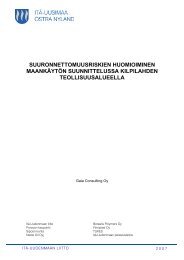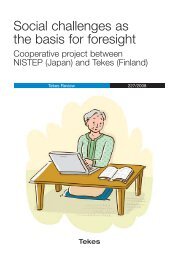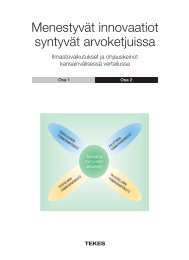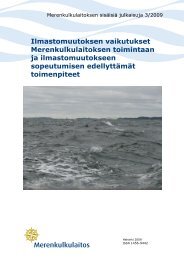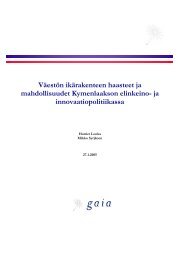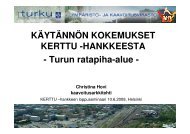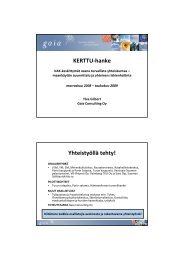Climate Risk Management in Finnish Development Cooperation - Gaia
Climate Risk Management in Finnish Development Cooperation - Gaia
Climate Risk Management in Finnish Development Cooperation - Gaia
You also want an ePaper? Increase the reach of your titles
YUMPU automatically turns print PDFs into web optimized ePapers that Google loves.
Figure 8. Composite (average of 19 Global <strong>Climate</strong> Models/GCMs) change <strong>in</strong> temperature (oC) relative<br />
to 1961-1990 normal for A1B emission scenario. Source NAPA.<br />
With regards to changes <strong>in</strong> precipitation there is<br />
likely to be an <strong>in</strong>crease <strong>in</strong> annual mean ra<strong>in</strong>fall <strong>in</strong><br />
Eastern Africa. 32 However, <strong>in</strong> comparison to<br />
temperature, ra<strong>in</strong>fall projections for Ethiopia are a<br />
lot less certa<strong>in</strong>. While show<strong>in</strong>g a tendency for slightly<br />
wetter conditions <strong>in</strong> the future (figure 9, provid<strong>in</strong>g<br />
one projection from NAPA), both <strong>in</strong>creases and<br />
decreases <strong>in</strong> ra<strong>in</strong>fall are predicted by the different<br />
models and scenarios, with considerable regional and<br />
seasonal differences.<br />
Figure 9. One projection for future change <strong>in</strong> annual ra<strong>in</strong>fall. Composite percentage change (%) <strong>in</strong><br />
ra<strong>in</strong>fall relative to 1961-1990 normal for A1B emission scenario. Source NAPA.<br />
The considerable regional and seasonal differences between climate model simulations of<br />
future ra<strong>in</strong>fall conditions warrants caution <strong>in</strong> <strong>in</strong>terpret<strong>in</strong>g the results. The usage of a range of<br />
scenarios to represent the uncerta<strong>in</strong>ty <strong>in</strong> future climate change impacts has been identified<br />
as one useful option to deal with these uncerta<strong>in</strong>ties <strong>in</strong> adaptation decision mak<strong>in</strong>g. 33 The<br />
wide range of potential ra<strong>in</strong>fall changes (regionally and seasonally) is presented <strong>in</strong> the<br />
projections is highlighted <strong>in</strong> the diversity of results <strong>in</strong> different scenario work. 34<br />
32 IPCC fourth assessment report, 2007.<br />
33 Uncerta<strong>in</strong>ties <strong>in</strong> ra<strong>in</strong>fall projection are partly expla<strong>in</strong>ed by: i) difficulties of GCMs to reproduce the mechanisms<br />
responsible for precipitation, ii) model limitations to simulate the different teleconnections and feedback<br />
mechanisms, which are responsible for ra<strong>in</strong>fall variability <strong>in</strong> Africa, and iii) other factors that complicate African<br />
climatology (e.g. at present there are no clear <strong>in</strong>dications of future behaviour <strong>in</strong> El Niño, associated with dry wet<br />
seasons <strong>in</strong> Ethiopia, and the Indian Ocean Dipole, which is sometimes associated with flood events dur<strong>in</strong>g<br />
October to December, and their possible <strong>in</strong>fluence on Ethiopian climate. Conway, D et al (2007). In general<br />
Model simulations show wide disagreements <strong>in</strong> projected changes <strong>in</strong> the amplitude of future El Niño events<br />
(Christensen et al., 2007). East Africa’s seasonal ra<strong>in</strong>fall can be strongly <strong>in</strong>fluenced by ENSO, and this contributes<br />
to uncerta<strong>in</strong>ty <strong>in</strong> climate projections, particularly <strong>in</strong> the future <strong>in</strong>ter-annual variability, for this region.<br />
34 See e.g. Conway, D et al (2007).<br />
16



